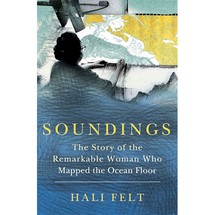Soundings: The Story of the Remarkable Woman Who Mapped the Ocean Floor
By Hali Felt
352 pages;
Henry Holt and Co.
At age 28, geologist Marie Tharpe began work at Columbia University as an assistant (read: glorified secretary). By the end of her tenure there in 1982, she and her colleague Bruce Heezen had mapped the ocean floor using sonar readings and, in the process, identified "the world-girdling rift valley" that laid the foundation for proving the theory of plate tectonics. Part race-to-the-finish tale of 20th-century scientific discovery and part unconventional romance of Tharpe and Heezen, Soundings makes the overlooked story of a scientist and her work crackle with energy, as well as tackles some frustrating questions. Heezen was given credit for his discoveries, while Tharpe was often completely ignored due to her gender. The author, Hali Felt, seems to take some solace in believing that Tharpe found satisfaction in the work and may (heavy, heavy emphasis on that "may") not have needed the recognition of others. Regardless, it's a real tragedy that Tharpe died before reading this literary tribute. Felt is a playful, wildly thoughtful writer, who can extrapolate meanings about our view of the past from outdated scientific terms like "uniformitarianism" and "catastrophism," and she addresses "the ins and outs of alarm clocks, washrags and frying eggs; light tables, ink pens and smooth sheets of white paper; erasers, fathoms and final drafts; lunch and more work and breathing and cooking dinner and waiting until the last minute before darkness to turn on the electric lights" that illuminate the text with the kind of evocative details that make the story of a real life so real.
— Leigh Newman


